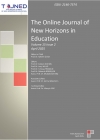TOJNED - Volume 2 - Issue 2 - April 2012
 AN EXPLORATION OF THE EPISTEMIC DIMENSION OF PRESERVICE TEACHERS IDENTITY
AN EXPLORATION OF THE EPISTEMIC DIMENSION OF PRESERVICE TEACHERS IDENTITY Raoul Adam
Abstract: This paper identifies and illustrates binary epistemic dynamics influencing the construction of preservice teachers pedagogical identity. An exploratory pilot study was used to explore epistemic change and constancy in preservice teachers (n = 19) identity across five binary constructs (e.g., nature/nurture) used to structure an introductory subject in a Graduate Diploma of Education. The study revealed instances of dynamic interactivity between structure and content influencing participants tendency to polarise, depolarise, neutralise, relativise, and correlate binary constructs. Some of these dynamics problematise epistemological theories which propose linear development between absolutist, multiplist, and evaluativist ways of knowing (Tabak & Weinstock, 2008). The study offers tentative support for incorporating epistemic pedagogies in preservice teacher education courses and expanding the dialogue over the direction and metaphor of development used to construct teachers epistemic identity.
 EVERYDAY LIFE AT THE LEISURE-TIME CENTRE
EVERYDAY LIFE AT THE LEISURE-TIME CENTRE Lisbeth Lindström
Abstract: In this article I present insights from research that has sought to deepen the perception of recreation leaders regarding leisure-time centres for young people (aged 6-12) and the contributions of these centres to the development and learning of children. Based on the research I argue that the relationship between entrepreneurship education and citizenship education is a close one, and it is possible for one to lend itself to the other and strengthen the development of an individual s skills for inclusion in society. In the first part of the paper I introduce the concept of the leisure-time centre and its connection to the Education Act and the curriculum for elementary school, preschool, and after-school. In the next two sections I describe the theoretical framework for entrepreneurship education and citizenship education. In the fourth part I present the research. In the fifth part I discuss and analyse the findings of the research.
 EXAMINING THE RELATIONSHIPS BETWEEN SCHOOL PRINCIPALS TRANSFORMATIONAL AND TRANSACTIONAL LEADERSHIP STYLES AND TEACHERS ORGANIZATIONAL COMMITMENT
EXAMINING THE RELATIONSHIPS BETWEEN SCHOOL PRINCIPALS TRANSFORMATIONAL AND TRANSACTIONAL LEADERSHIP STYLES AND TEACHERS ORGANIZATIONAL COMMITMENT Necati CEMALOĞLU, Ferudun SEZGİN, Ali Çağatay KILINÇ
Abstract: The purpose of this study was to determine the relationships between school principals transformational and transactional leadership styles and teachers organizational commitment. A total of 237 primary school teachers employed in Ankara participated in the study. The "Multi-Factor Leadership Questionnaire" developed by Bass and Avolio (1995) and "Organizational Commitment Questionnaire" developed by Allen and Meyer (1990) were used to gather data. Results indicated that school principals were more likely to perform transformational leadership style than transactional leadership styles. Teachers commitment scores were the highest in continuance commitment. There were significant relationships between transformational and transactional leadership styles of principals and organizational commitment of teachers. Results also showed that motivation by inspiration and individualized consideration predicted affective commitment significantly. While contingent reward dimension of leadership styles was the only significant predictor of teacher continuance commitment, management by exceptions (passive) and laissez-faire significantly predicted normative commitment.
 THE MATHEMATICS EDUCATION FOR THE ENGINEERING STUDENTS OF 21ST CENTURY
THE MATHEMATICS EDUCATION FOR THE ENGINEERING STUDENTS OF 21ST CENTURY Figen Uysal
Abstract: Engineering is one of the most important professions for the mathematics discipline. New developments in engineering have stimulated new areas of mathematical research. Control theory, signal processing and coding theory are all examples for this. When taking into account the close relationship between engineering and mathematics, we can easily say that mathematics have a vital role in the engineering education. In the last twenty years, both new demands of the engineering profession and inadequate mathematics ability of the engineering students have led in a big change in the scope of the mathematics education. The recent developments in technology and computers have caused variation in teaching mathematics of engineering students and have brought with them the use of modern techniques and methods. This research aims to shed some light on how the mathematics education, which is an important part of the engineering education for the 21st century engineers, must be, by investigating the curriculum, teaching and measurement–assessment methods.
 VISUAL LITERACY SCALE: THE STUDY OF VALIDITY AND RELIABILITY
VISUAL LITERACY SCALE: THE STUDY OF VALIDITY AND RELIABILITY Aydın KİPER, Serhat ARSLAN, Mübin KIYICI, Özcan Erkan AKGÜN
Abstract: Visual materials like pictures, graphics, and videos that are encountered frequently in the printed and visual areas such as television, web sites, newspapers, journals, and books; as well as in daily life like highways, air ways, cars, and schools are nowadays inseparable parts of daily life. With the development of new technologies and communication methods, these visuals are aimed to be utilized more efficiently. Visuality, which plays an efficient role in the communication, is especially important for individuals, and especially for students, to remember what they have read. The aim of the present study was to develop a reliable and valid instrument for assessing students qualifications in visual literacy. The sample of the study consisted of 506 students (307 females/ 199 males) from Sakarya University, Faculty of Education. Ages of the participants ranged between 17 and 30, with a mean of 19.7 (SD = 1.54). In the validity studies of the instrument, professional views were consulted for face validity and content validity. While the questionnaire for students visual literacy was being developed, literature review was conducted and an item pool consisting of 43 items was formed. Taking into account the professional views of visual literacy scale, a 5-point likert type scale was applied for referring to the level of evaluation. In the validity studies, initially 5 expert were determined in order to consult for face and content validities. The questionnaire was presented to the academicians from departments of education technology, psychological counselling, assessment and evaluation, and Turkish language, in order to consult for their views. Taking into account the views and critiques, the questionnaire items were subjected to required revisions and deletions. Accordingly, the questionnaire was formed with 29 items assessing students qualifications in visual literacy and the subsequent reliability and validity studies were conducted using this form. The reliability and validity studies were conducted with the study sample. First of all, exploratory factor analysis (with principle component analysis method) was applied for construct validity. The results of the exploratory factor analysis yielded 6 factors. For questionnaire reliability, internal consistency coefficients were calculated. The internal consistency coefficient of the questionnaire was found to be .94, indicating that the psychometric properties of the questionnaire are within the acceptable limits. To conclude, the questionnaire for qualifications in visual literacy developed in this study is a reliable and valid instrument that can be used for determining university students qualifications in visual literacy. Questionnaire for visual literacy can be utilized in the literature considering the assessment of students qualifications for visual literacy. It is recommended that, by using this instrument, students qualifications in visual literacy, the dimensions in which their visual literacy levels are qualified, and whether there is a difference in the qualifications and opinions for visual literacy in terms of demographic variables can be examined.


